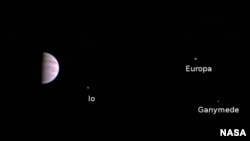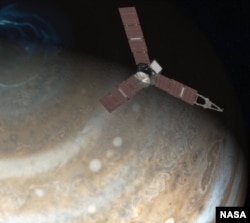This Saturday, NASA's Juno spacecraft will get its closest look at Jupiter.
After spending five years in space, Juno is now poised to make its closest pass to the solar system's largest planet.
According to NASA's Jet Propulsion Laboratory, at about 8:51 a.m. Eastern time, Juno "will be about 4,200 kilometers above Jupiter's swirling clouds and traveling 208,000 kilometers per hour with respect to the planet."
That doesn't seem that close until you consider that Jupiter is over 140,000 kilometers in diameter. As a point of reference, Earth is 12,700 kilometers in diameter.
NASA scientists are excited because it will be the first flyby since Juno entered Jupiter orbit on July 4, and it's also the first time all of its onboard instruments will be fired up and ready to go.
Scott Bolton, principal investigator for the Juno mission, said, "This is our first opportunity to really take a close-up look at the king of our solar system and begin to figure out how he works."
NASA said Juno's principal goal is to understand the evolution and origin of Jupiter.
It will do this by measuring the amount of water in Jupiter's atmosphere, as well as its "composition, temperature, cloud motions and other properties. It will map Jupiter's magnetic and gravity fields, and explore and study Jupiter's magnetosphere near the planet's poles, especially the auroras — Jupiter's northern and southern lights — providing new insights about how the planet's enormous magnetic force field affects its atmosphere."
That's a lot to do, but Juno has at least 20 months to do its work.
Don't hold your breath
Even though this will be Juno's first pass by Jupiter and even though it will be collecting a lot of information, don't expect to see or hear anything really cool anytime soon.
The information will take some time to get back here to Earth, and then once it's here, NASA has to do a fair bit of what it calls "interpretation and results" before us amateurs can enjoy the view from Juno.
Steve Levin from NASA's Jet Propulsion Laboratory said, "This is our first opportunity, and there are bound to be surprises. We need to take our time to make sure our conclusions are correct."










